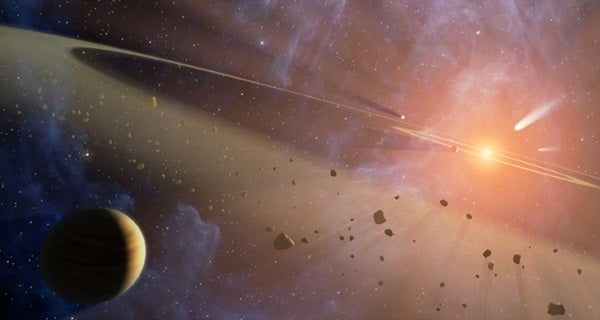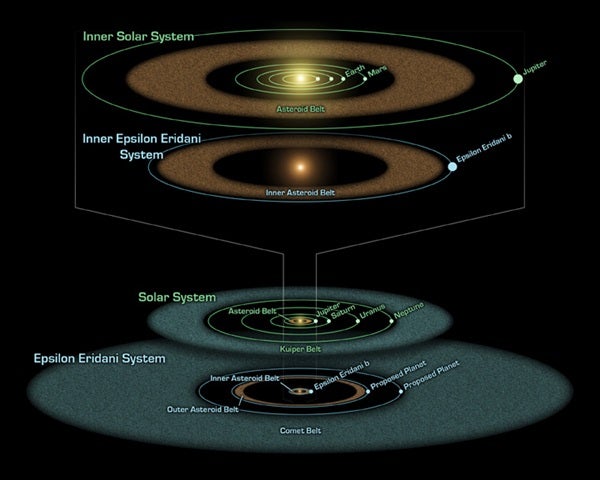Astronomers discovered the nearby star Epsilon Eridani has two rocky asteroid belts and an outer icy ring, making it a triple-ring system. The inner asteroid belt is a virtual twin of the asteroid belt in our solar system, while the outer asteroid belt holds 20 times more material. Moreover, the presence of these three rings of material implies that unseen planets confine and shape them.
The star Epsilon Eridani is slightly smaller and cooler than the Sun. It is located about 10.5 light-years from Earth in the constellation Eridanus. Epsilon Eridani is the ninth closest star to the Sun and is visible to the unaided eye. It is also younger than the Sun, with an approximate age of 850 million years.
Epsilon Eridani and its planetary system show remarkable similarities to our solar system at a comparable age.
“Studying Epsilon Eridani is like having a time machine to look at our solar system when it was young,” said Smithsonian astronomer Massimo Marengo. Marengo is a co-author of the discovery paper, which will appear in the January 10 issue of The Astrophysical Journal.
Lead author Dana Backman (Search for Extraterrestrial Intelligence Institute) said, “This system probably looks a lot like ours did when life first took root on Earth.”
Our solar system has a rocky asteroid belt between Mars and Jupiter. In total, it contains about 1/20 the mass of Earth’s Moon. Using NASA’s Spitzer Space Telescope, the team of astronomers found an identical asteroid belt orbiting Epsilon Eridani.
A third, icy ring of material seen previously extends about 35 to 100 astronomical units from Epsilon Eridani. A similar icy reservoir in our solar system is called the Kuiper Belt. However, Epsilon Eridani’s outer ring holds about 100 times more material than ours.
When the Sun was 850 million years old, theorists calculate that our Kuiper Belt looked about the same as that of Epsilon Eridani. Since then, much of the Kuiper Belt material was swept away, some hurled out of the solar system and some was sent plunging into the inner planets in an event called the Late Heavy Bombardment. The Moon shows evidence of the Late Heavy Bombardment — giant craters that formed the lunar seas of lava called mare. It is possible that Epsilon Eridani will undergo a similar dramatic clearing in the future.
“Epsilon Eridani looks a lot like the young solar system, so it’s conceivable that it will evolve similarly,” said Marengo.
The Spitzer data show gaps between each of the three rings surrounding Epsilon Eridani. Such gaps are best explained by the presence of planets that gravitationally mold the rings, just as the moons of Saturn constrain its rings.
“Planets are the easiest way to explain what we’re seeing,” stated Marengo.
Specifically, three planets with masses between those of Neptune and Jupiter would fit the observations nicely. Radial velocity studies have detected a candidate planet near the innermost ring already. Those studies suggested that it orbited Epsilon Eridani on a highly elliptical path, characterized by an eccentricity of 0.7. The new finding rules out such an orbit, because the planet would have cleared out the inner asteroid belt long ago through gravitational disruption.
A second planet must lurk near the second asteroid belt, and a third at about 35 astronomical units near the inner edge of Epsilon Eridani’s Kuiper Belt. Future studies may detect these currently unseen worlds, as well as any terrestrial planets that may orbit inside the innermost asteroid belt.











